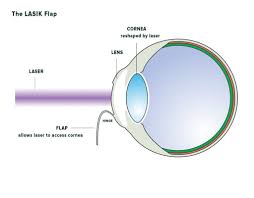Table of Contents
ToggleYes, it is possible to experience a return of minus (myopia) after LASIK, though it’s not common for most patients.
This phenomenon, known as regression, can occur due to various factors, including natural changes in the eye or the initial treatment parameters.
If you’re considering LASIK or have already undergone the procedure, understanding whether your vision can regress and what influences the stability of your results is crucial. Below, we’ll explore why and how minus can reappear, preventative measures, and what you can do if it happens.
LASIK and Its Long-Term Effects
How LASIK Corrects Your Vision?
LASIK (Laser-Assisted in Situ Keratomileusis) is a laser eye surgery designed to correct refractive errors, including myopia, hyperopia, and astigmatism. The surgeon reshapes your cornea to ensure light focuses correctly on the retina, leading to clear, sharp vision without the need for glasses or contact lenses.
The goal of LASIK is to provide a permanent solution to refractive errors. For the majority of patients, LASIK delivers stable results that last for many years.
Can LASIK Fully Prevent Regression?
While LASIK reshapes the cornea to correct vision, it doesn’t stop natural ageing processes or other external factors that might alter the eye later. Vision regression, especially the return of minus (myopia), can occur in a subset of patients, but it’s not a certainty. Here’s why:
- The natural lens of the eye can continue to change as part of the ageing process.
- Pre-existing conditions, like progressive myopia, may continue despite LASIK.
- External factors, such as excessive screen use or poor eye care habits, can affect eye health over time.
What Is Normal Post-LASIK Recovery?
After undergoing LASIK, your vision typically stabilises within 3 to 6 months. During this healing period, light fluctuations in vision are normal as your cornea adjusts to the reshaping process. Regression usually becomes evident months or years after this stabilisation phase.
Causes Behind Regression After LASIK
Residual or Progressive Myopia
One of the main causes of returning minus (myopia) after LASIK is residual or progressive nearsightedness. If you have a naturally high prescription before LASIK, some residual error may remain after the surgery, or progression might continue due to genetic predisposition.
- High Myopia Patients: Those with an extremely high prescription pre-surgery are more likely to experience regression.
- Adolescent Myopia: For individuals whose myopia was aggressively progressive during adolescence, LASIK cannot halt this process.
Age-Related Changes
While LASIK effectively corrects refractive errors, it doesn’t prevent age-related vision shifts such as presbyopia or cataracts.
- Presbyopia is a condition that affects near vision as people age, generally starting around age 40. This is unrelated to myopia but may create the perception of vision changes.
- Cataracts cloud the natural lens, leading to blurry vision. They can also introduce refractive shifts unrelated to LASIK.
Poor Healing or Over or Under-Correction
Although rare, over or under-correction during the LASIK procedure could result in incomplete visual correction. Similarly, if the cornea doesn’t heal as expected, it might lead to a less-than-optimal outcome. These instances are more likely in patients with specific pre-existing eye conditions.
Lifestyle and Environmental Factors
Your lifestyle can also significantly impact whether regression occurs. Excessive screen usage, poor UV protection, or a lack of breaks during visually taxing work can strain your eyes and potentially hasten regression over time.
- Eye Fatigue from screen-heavy jobs can aggravate eye strain.
- UV Exposure has been linked to corneal changes that may further affect vision even after LASIK.
- Improper Eye Care increases the risk of dry eyes or other complications post-LASIK.
How Often Does Regression Occur?
Regression is estimated to affect around 5-10% of LASIK patients. For the vast majority, LASIK results are stable and provide a clear vision for many years, if not permanently. However, some patients may require an enhancement procedure to fine-tune their results.
Who Is More Likely to Experience Regression?
1. Patients Under Age 20
If LASIK is performed while the eyes are still changing, regression is more likely as the eye continues to grow.
2. People with High Myopia
Those with extreme prescriptions may see partial regression due to the limitations of LASIK in correcting very high levels of refractive error.
3. Patients With Poor Eye Health
Individuals with pre-existing conditions like keratoconus or chronic dry eye may experience complications that contribute to regression.
4. Age-Related Factors
Older patients may experience shifts in their vision due to presbyopia or cataracts, as discussed earlier.
Preventing Regression After LASIK
Follow Post-Operative Instructions
One of the most effective ways to avoid regression is by following the post-operative care regimen provided by your surgeon. This includes avoiding strenuous activity, using prescribed eye drops, and attending all follow-up appointments.
Regular Eye Screenings
Ongoing eye care is essential. Visit your eye doctor annually to monitor your vision, even after LASIK. Regular exams can catch regression early and ensure timely intervention.
Protect Your Eyes
Adopt healthy habits to reduce strain on your eyes and protect your vision:
- Wear sunglasses with UV protection.
- Take breaks during screen-heavy work.
- Maintain proper hydration and use lubricating eye drops to prevent eye dryness.
What Can Be Done If Regression Occurs?
Enhancement Procedures
For patients who do experience regression, a follow-up LASIK enhancement is often an effective solution. This involves repeating the laser procedure to correct the vision changes. Enhancement procedures are generally safe, assuming there is adequate corneal tissue remaining. Most LASIK enhancement procedures are performed within 1-2 years of the initial treatment.
Prescription Glasses or Contact Lenses
For patients who can’t or opt not to undergo enhancement, a minor prescription for glasses or contacts might be sufficient to correct their vision.
Alternative Vision Treatments
If enhancement is not advisable due to corneal thickness or other factors, other surgeries, like PRK (Photorefractive Keratectomy), may be considered. PRK is a laser-based alternative for individuals with thinner corneas.
Does Minus Always Return After LASIK?
It’s important to reiterate that for the vast majority of LASIK patients, minus does not return. LASIK has a high satisfaction rate, with most patients enjoying clear vision for years, if not indefinitely. However, regression is a possibility influenced by factors both within and beyond your control.
Remaining proactive with your eye care, maintaining a healthy lifestyle, and staying informed about changes in your vision are essential steps to maximising the benefits of LASIK.
What Patients Should Know Before Having LASIK?
If you’re considering LASIK, it’s crucial to discuss the potential for regression with your surgeon. Having realistic expectations about the outcomes and potential changes in your vision over time is key.
Questions to Ask Your LASIK Surgeon:
- How likely is regression in my case, given my prescription and eye health?
- What follow-up care or enhancement procedures would be available if regression occurs?
- How can I best maintain long-term results post-LASIK?
LASIK and Stable Vision for the Future
While it’s possible to experience minus again after LASIK, most patients enjoy long-lasting results that significantly improve their quality of life. By choosing an experienced surgeon, adhering to care advice, and prioritising eye health, you can greatly reduce the risks of regression.
If you’re considering LASIK or have concerns about your post-surgery vision, schedule a consultation with a trusted eye care professional. With the right steps, a crisp and clear vision can truly remain a reality for years to come.













